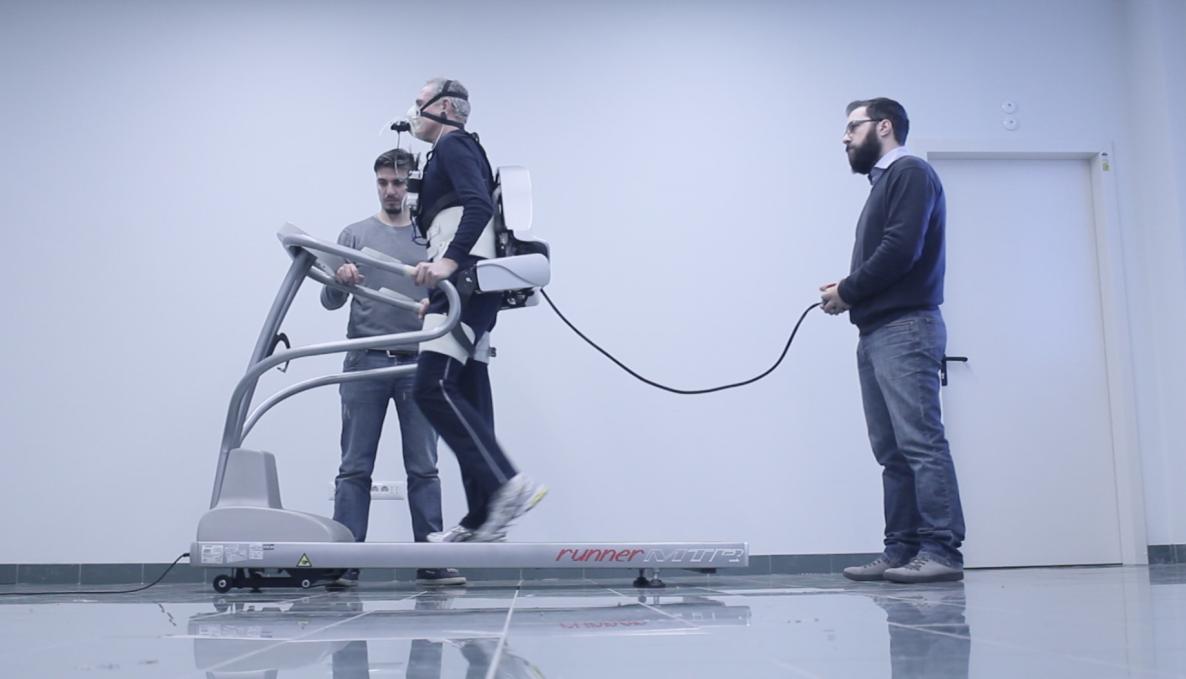wearable Robotic Exoskeleton improves metabolic gait efficiency in the elderly. SCIENTIFIC REPORTS publishes A new study supervised by researchers of SANT’ANNA school BIOROBOTICS INSTITUTE

Robotic exoskeletons are regarded as promising technologies for neurological gait rehabilitation but have been investigated comparatively little as training aides to facilitate active aging in the elderly. A new study titled “Gait training using a robotic hip exoskeleton improves metabolic gait efficiency in the elderly” and published in Scientific Reports journal, highlights the adoption of exoskeletal devices for the training of frail individuals, showing new sustainable strategies for older people housing and healthy aging.
The paper, under the supervision of researchers from Sant’Anna School Biorobotics Institute, the CNR- Pisa Institute of Clinical Physiology and the Fondazione Don Carlo Gnocchi, aims to improve the assistance, rehabilitation and housing environment of the elderly in order to enhance their quality of life. World Health Organization experts devised a “global strategy and action plan on aging and health 2016–2020” designed to improve the physical and spiritual health as well as social welfare of the elderly.
Researchers of Sant’Anna School Biorobotics Institute, the CNR- Pisa Institute of Clinical Physiology and the Fondazione Don Carlo Gnocchi demonstrated the superiority of eccentric strength training over the traditional approach in increasing muscular strength and functional abilities. Exoskeletons designed for robot-assisted rehabilitation programs under the European Commission FP7 and H2020 funded projects CYBERLEGs, CYBERLEGs Plus Plus, and project IUVO funded by the Fondazione Pisa, have evolved to improve walking efficiency of stroke survivors and ambulatory capabilities in spinal cord injury patients.
“The concept of “active-” or “successful aging” has emerged in recent years as a strategy to promote physical and mental health through aging, primarily by the adoption of active behaviors and the use of exoskeletons – said Elena Martini, PhD student of the Biorobotics Institute, as the first author. As the elderly face higher metabolic demands for activities of daily living and exhibit slower walking speeds in addition to limited ranges of motion, we are required to design specific training paradigms accounting for age-related frailty and disabilities”.
Twenty healthy elderly volunteers were recruited for the study. Suitable candidates were identified as moderately active individuals aged 65 -85. The participants were randomly assigned to the experimental APO group (age 70 ± 5 years; 2 female/8 male; BMI 28.4 ± 2.9 kg/m2) followed a robot-assisted training program, while ten participants in the control group (age 70 ± 4 years; 7 female/3 male; BMI 28.7 ± 4.5 kg/m2), performed self-paced overground walking.
Data were analyzed to assess changes in gait efficiency related to robot-assisted training, as an indicator of efficiency and cardio-pulmonary fitness. Ten volunteers exhibited a decreased Metabolic Cost of Transport (MCoT) during treadmill walking following a 4-week APO-assisted training program, while no significant changes were observed for the control group. Moreover, robot-assisted locomotion was found to require less oxygen consumption than free treadmill walking at the same speed.
“These findings on the effectiveness of eccentric strength training for the elderly constitute a promising proof of feasibility that paves the way for the further investigations of exoskeletons as enabling technologies” - said Simona Crea, as the supervisor of the Wearable Robotics Lab. at the Biorobotics Institute.
Lorenza Pratali, cardiologist at the CNR Institute of Clinical Physiology, highlights the adoption of exoskeletal devices for the training of old individuals suffering from diabetes or hypertension as a powerful strategy to promote physical and mental health through aging”.
“The clinical significance of the present results may be appreciated with respect to previous studies and in enabling technologies and smart industrial robotics within a networked production system” said Nicola Vitiello, as the deputy coordinator of Wearable Robotics Lab. and the founder of IUVO S.r.l.spin-off company as a partner of Comau, a member of the FCA Group and global leader in advanced industrial automation products and solutions and ÖSSUR, a leading non-invasive orthopedics.



